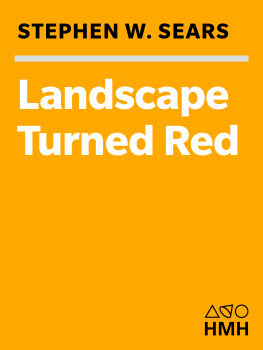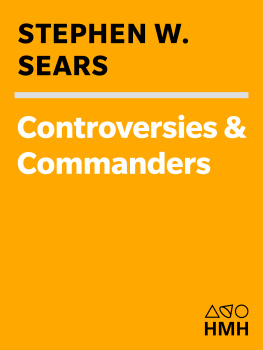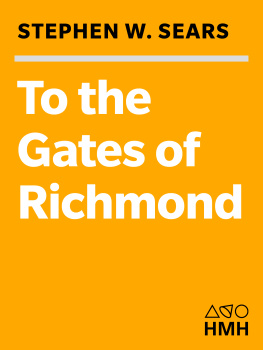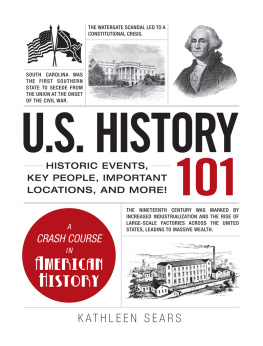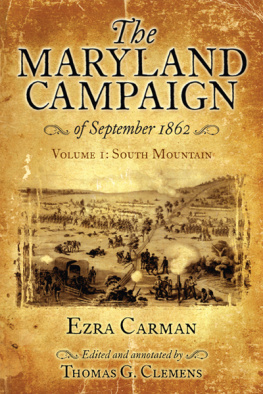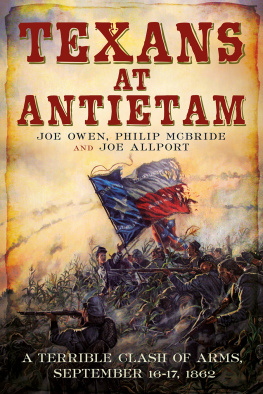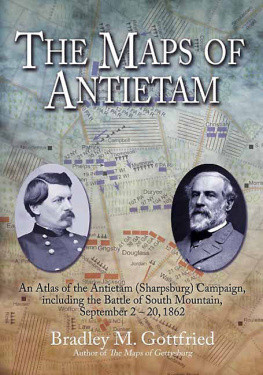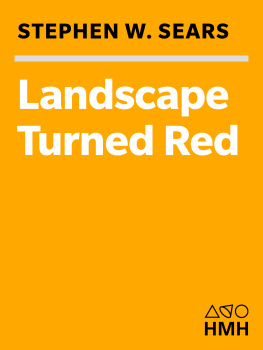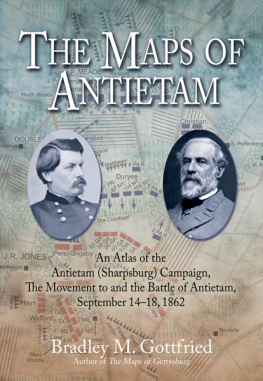First Mariner Books edition 2003
Copyright 1983 by Stephen W. Sears
All rights reserved
For information about permission to reproduce selections from this book, write to Permissions, Houghton Mifflin Harcourt Publishing Company, 215 Park Avenue South, New York, New York 10003.
www.hmhco.com
The Library of Congress has cataloged the print edition as follows:
Sears, Stephen W.
Landscape turned red.
Bibliography: p.
Includes index.
ISBN 0-89919-172- X
ISBN 0-618-34419-5 (pbk.)
Antietam, Battle of, 1862. I. Title.
E 474.65. S 43 1983
973-7'336 82-19519
e ISBN 978-0-547-52663-8
v1.0115
Maps by Herbert S. Borst
Acknowledgment is made for permission to quote from the following copyrighted works:
I Rode with Stonewall, by Henry Kyd Douglas. Copyright 1940 The University of North Carolina Press. By permission of the publisher.
A Virginia Yankee in the Civil War: The Diaries of David Hunter Strother, edited by Cecil D. Eby, Jr. Copyright 1961 The University of North Carolina Press. By permission of the publisher.
The General to His Lady: The Civil War Letters of William Dorsey Pender to Fanny Pender, edited by William W. Hassler. Copyright 1965 The University of North Carolina Press. By permission of the publisher.
From the Cannons Mouth. The Civil War Letters of General Alpheus S. Williams, edited by Milo M. Quaife. Copyright 1959 Wayne State University Press. By permission of the Wayne State University Press.
The Diary of George Templeton Strong The Civil War, 18601865, edited by Allan Nevins and Milton H. Thomas. Copyright 1952 by MacMillan Publishing Co., Inc., renewed 1980 by Milton Halsey Thomas. By permission of the publisher.
Dear Belle: Letters from a Cadet and Officer to His Sweetheart, 18381865, narrative and editing by Catherine S. Crury, foreword by Bruce Catton. Copyright 1965 by Wesleyan University. By permission of Wesleyan University Press.
Lincoln and the Civil War in the Diaries and Letters of John Hay, edited by Tyler Dennett. Copyright 1939 Dodd, Mead & Company. Inc. By permission of the publisher.
Civil War Letters of George Washington Whitman, edited by Jerome M. Loving. Copyright 1975 Duke University Press, Durham, N.C. By permission of the publisher.
For Sally T.
Maps
The Invasion of Maryland, September 313, 1862
McClellans Offensive at South Mountain, September 14, 1862
Battle of Turners Gap, September 14, 1862
Battle of Cramptons Gap, September 14, 1862
Battle of Antietam, September 17, 1862, Situation at Daybreak
Battle of Antietam, Attack of the Federal First Corps, 6:007:30 A.M.
Battle of Antietam, Attack of the Federal Twelfth Corps, 7:309:00 A.M.
Battle of Antietam, Attack of the Federal Second Corps, 9:00 A.M.1:00 P.M.
Battle of Antietam, Attack of the Federal Ninth Corps, 10:00 A.M.4:30 P.M.
Battle of Antietam, Situation at Nightfall
Introduction
Of all the days on all the fields where American soldiers have fought, the most terrible by almost any measure was September 17, 1862. The battle waged on that date, close by Antietam Creek at Sharpsburg in western Maryland, took a human toll never exceeded on any other single day in the nations history. So intense and sustained was the violence, a man recalled, that for a moment in his minds eye the very landscape around him turned red.
By almost any measure, too, Antietam was pivotal in the history of the Civil War. In September 1862 events across a broad spectrummilitary, political, social, diplomaticwere rushing toward a climax. The battle in Maryland would affect all of them radically, turning the course of the war in new directions.
It was a time of opportunity for the South and of peril for the North. Robert E. Lee had carried the war from Richmond to Washington and now led his army northward into Maryland in a bold effort to win independence for the Confederacy. The European powers, closely debating intervention in the American contest, were watching Lees progress intently. Confederate armies were also on the offensive in the western theater. The Union cause was at its nadir. The Federal army girding to meet Lee, stricken with a crisis of confidence, was entrusted to George B. McClellan, a general many believed to be gravely flawed as a commander. There was growing discontent in the Northern states with the administrations management of the conflict. Abraham Lincolns political support was divided and wavering even as he grappled with a revolutionary change of purpose, seeking to make this a war against slavery as well as a war for union. When the two armies finally faced one another across the shallow valley of the Antietam and prepared for battle, the sense of crisis was palpable. With his flair for the dramatic, General McClellan announced that the fate of the Republic was at stake, and so indeed it seemed.
This account of the Maryland campaign, of the complex backdrop against which it was played, and of the desperate struggle along the banks of the Antietam is drawn in large part from the testimony of eyewitnesses. There was in this settingthe pastoral Maryland countryside, the rugged terrain at Harpers Ferry and South Mountain, the rolling farmland and open woodlots around Sharpsburga particular sense of history being made that set it apart from previous campaigning and inspired men to record their impressions in detail in journals and letters. Their accounts are an invaluable supplement to the official reports and dispatches and battlefield messages.
Beyond providing such primary source materials, Antietam is unique in being the subject of an in-depth nineteenth-century historical research project. In the postwar years two participants in the battle, Colonel Ezra A. Carman of the 13th New Jersey and Major John M. Gould of the 10th Maine, undertook a survey of thousands of Antietam veterans, from both armies, to compile their recollections of the fighting. This materialused here for the first time in a published narrative of the campaignbears vivid witness to what it was like on that terrible field. In answering the questions posed by Carman and Gould, the veterans repeatedly stressed that no matter how many other battles they endured during the war, there was nothing quite like that bloody seventeenth of September. As one Southerner put it, after the passage of time it might seem almost impossible to remember with any degree of accuracy, circumstances that took place then. But these things are indelibly impressed upon my memory... In these recollections is abundant evidence that the struggle along Antietam Creek was the most bitter and savage of the Civil War.
PROLOGUE
The Last, Best Hope
Charles Francis Adams, Jr., first lieutenant in the 1st Massachusetts cavalry, grandson and great-grandson of presidents, was in Washington to take the national pulse. He was shaken by what he found. At a writing table in one of the parlors in Willards Hotel he set down his impressions for his father, the American minister to the Court of St. Jamess in London.
I think I can give you a little more light than you now have, young Adams wrote under the date August 27, 1862. Do you know that in the opinion of our leading military men Washington is in more danger than it ever yet has been? Do you know that but for McDowells jealousy we should have triumphantly marched into Richmond? Do you know that Pope is a humbug and known to be so by those who put him in his present place? Do you know that today he is so completely outgeneraled as to be cut off from Washington? The Union cause was in deep crisis, he continued. Our rulers seem to me to be crazy. The air of this city seems thick with treachery; our army seems in danger of utter demoralization.... Everything is ripe for a terrible panic, the end of which I cannot see or even imagine. He had looked in vain for a silver lining. It is my glimpse behind the scenes, the conviction that small men with selfish motives control the war without any central power to keep them in bounds, which terrifies and discourages me.
Next page
